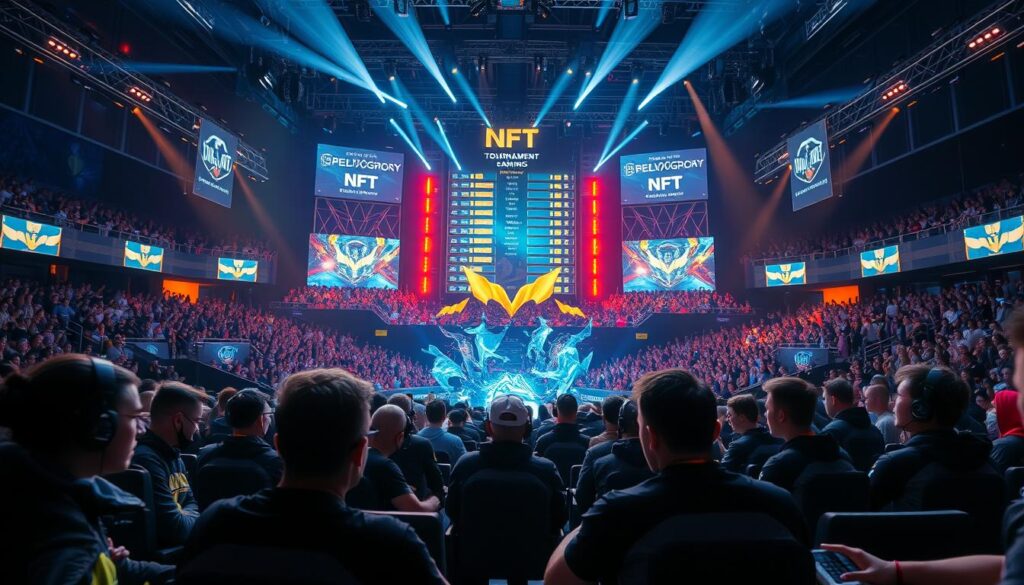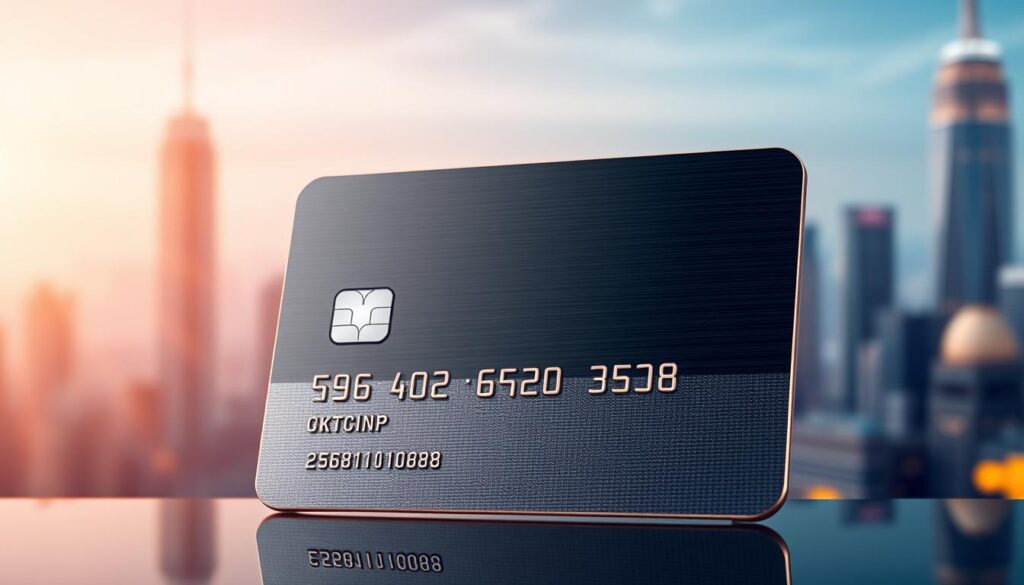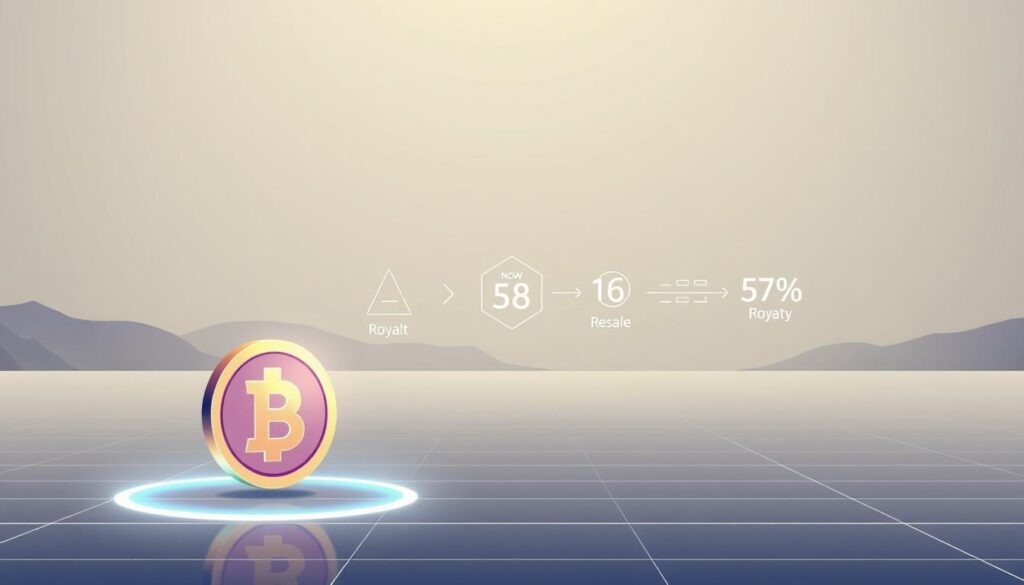Now Reading: Unlock the Power of NFT Creator Royalties
- 01
Unlock the Power of NFT Creator Royalties
Unlock the Power of NFT Creator Royalties
Digital artists and innovators now have a groundbreaking way to earn from their work long after the first sale. Built into blockchain transactions, automatic payments ensure original makers receive a share every time their art resells. This system reshapes how value flows in the digital economy.

These payments, typically between 2.5% and 10%, are programmed during the initial launch phase. The average rate sits near 6%, creating reliable income streams. High-profile sales like Everydays: The First 5000 Days ($69.3 million) show how these models reward talent at scale.
Blockchain technology makes this possible through unchangeable agreements that execute automatically. Marketplaces handle the details, letting artists focus on their craft while building lasting revenue. However, strategies vary across platforms, requiring careful planning to maximize benefits.
Key Takeaways
- Automatic resale payments create ongoing income for digital artists
- Smart contracts enforce payment terms without third parties
- Average rates range from 2.5% to 10%, with 6% being common
- Major sales demonstrate significant earning potential
- Platforms differ in how they handle payment enforcement
Understanding NFT Creator Royalties and Their Impact
The digital economy is transforming how artists earn from their creations, thanks to innovative compensation models built into blockchain technology. These systems automatically share profits with originators during resales, ensuring fair rewards for their contributions.

What Are NFT Creator Royalties?
Automated resale payments give makers ongoing income whenever their digital work changes hands. Built into blockchain agreements during initial launches, these terms range from 2.5% to 10% of secondary sale prices. For example, electronic musician Jacques Greene earned $27,000 from a single track’s resales, while digital artist Mike Winkelmann secured 10% for all future transactions of his pieces.
Why They Matter for Artists and Creators
This model creates passive income streams that traditional art markets rarely offer. Unlike physical artwork sales—where tracking resales requires legal teams—blockchain handles payments instantly. Stars like Steve Aoki and bands such as Kings of Leon use these systems to build sustainable careers while nurturing collector relationships.
Emerging talents benefit equally, gaining access to revenue models once reserved for established names. By eliminating middlemen, creators keep more money while focusing on their craft. Explore how these secondary sales mechanisms empower artists across industries.
How NFT Royalties Work Through Smart Contracts
Automated payment systems are redefining value distribution in digital ownership through self-executing code. These systems use blockchain-based agreements to ensure fair compensation whenever assets change hands. Unlike traditional methods, they operate without intermediaries, making transactions faster and more transparent.
The Role of Smart Contracts in Enforcing Royalties
Self-operating agreements act as digital rulebooks, automatically transferring a set percentage of resale profits to original makers. Lawyers Adam Chernichaw and Pratin Vallabhaneni note these contracts trigger payments when specific events occur, like asset transfers. The code ensures compliance, eliminating manual tracking or disputes.
Customizing Royalty Terms on the Blockchain
Artists can design payment structures tailored to their needs. Options include perpetual income streams or time-limited agreements (e.g., 1-20 years). Some set higher rates for initial resales, while others apply flat fees. The blockchain’s unchangeable nature locks these terms permanently unless all parties approve updates.
Case Examples from Leading Platforms
Major marketplaces showcase diverse approaches. One platform automatically deducts 10% from secondary sales, routing funds directly to wallets. Another uses hybrid models where collectors voluntarily honor payments. These systems reduce administrative costs while ensuring timely compensation for digital work.
NFT Creator Royalties in the Marketplace Ecosystem
Digital ownership platforms operate through distinct phases that shape earnings. Initial transactions launch works into circulation, while subsequent trades fuel long-term value growth. This structure creates multiple profit opportunities tied to an artwork’s lifecycle.

How Primary and Secondary Sales Differ
First-time transactions typically give makers 85% of proceeds. Platforms like SuperRare take 15% fees during this phase. When collectors later resell items, automated percentages kick in. A piece selling for 10 ETH initially could yield 20 ETH for its maker if resold for 200 ETH with 10% terms.
Revenue Streams for Artists and Content Creators
Smart platform choices let makers earn from both sale types simultaneously. Centralized venues often enforce payment rules, while decentralized ones may leave compliance to buyers. Diversifying across platforms builds stability – one piece can generate income through multiple channels.
Established marketplaces attract more buyers but charge higher fees. Emerging platforms offer lower costs but smaller audiences. Successful makers balance visibility with profit retention, often listing works across several sites. Regular policy reviews ensure alignment with changing industry standards.
Technical and Legal Perspectives on NFT Royalties
The fusion of code and law reshapes how digital creators secure their earnings. While blockchain systems automate royalty payments, traditional legal frameworks struggle to keep pace with this innovation. This gap creates both opportunities and challenges for protecting long-term income streams.

Blockchain Technology Versus Traditional Contracts
Self-executing code enforces payment terms automatically, but its legal standing remains unclear. Lawyers Adam Chernichaw and Pratin Vallabhaneni note these systems are “neither smart nor contracts” under conventional law. Unlike paper agreements, blockchain transactions operate through irreversible code rather than court-enforceable terms.
U.S. property law typically transfers full ownership rights during sales, conflicting with perpetual royalty concepts. Digital assets split into three parts: the artwork, token, and platform rules. Proper legal documentation bridges these elements for enforceable rights.
Insights from Blockchain Lawyers and Legal Experts
Jurisdictional differences create uncertainty. Some regions recognize automated payments as valid, while others require traditional contracts. Tech solutions work best when paired with written agreements detailing intellectual property rights.
Platform fees and payment timelines vary widely, demanding careful review. Experts advise updating strategies as regulations evolve. Combining blockchain efficiency with legal safeguards offers the strongest protection for digital earnings over time.
Implementing Strategies to Maximize Your Earnings
Building sustainable income from digital assets requires careful strategy and platform knowledge. Success hinges on understanding how different marketplaces handle payments and configuring terms that benefit both makers and collectors.
Step-by-Step Guide to Setting Up Royalties
Start by comparing platform policies. Some enforce automatic payments, while others leave compliance to buyers. Choose venues aligning with your goals – high-traffic sites often take larger fees but offer wider exposure.
Configure your smart contract parameters carefully. Most makers set percentages between 5% and 8%, balancing earnings with buyer appeal. Test transactions on testnets to ensure payments trigger correctly before launching publicly.
Tips for Negotiating with NFT Marketplaces
Research each platform’s revenue model before discussions. Smaller markets may offer better terms to attract quality work. Propose tiered structures – lower rates for initial sales, higher cuts for pricier resales.
Build relationships with platform managers. Demonstrating your collection’s potential can unlock promotional support or fee reductions. Always document agreements clearly, especially when dealing with non-fungible tokens that might move between wallets.
Regularly review your strategy as markets evolve. Adjust percentages based on collector feedback and sales data to keep your money streams flowing long-term.
Real-World Examples and Marketplace Practices
Digital ownership platforms showcase diverse approaches to compensation models. Recent sales and policy shifts reveal how artists navigate this evolving landscape.
Featured Case Studies and High-Value Sales
The Merge collection generated $91.8 million, with automatic payments flowing to wallets long after initial drops. Another example: Everydays’ $69.3 million sale continues delivering income through secondary transactions. These successes prove well-structured terms create lasting value.
Platform Policies: Enforced vs. Optional Payments
Nifty Gateway automatically deducts 10% from resales, while Foundation applies 5% fees at the platform level. SuperRare enforces a 10% minimum during secondary transactions. In contrast, OpenSea and Magic Eden let buyers choose whether to honor payment terms, creating uneven revenue streams across marketplaces.
Trends Shaping Digital Asset Markets
2023 saw major platforms shift toward optional systems. Magic Eden’s policy change highlights the balance between companies competing for users and protecting maker interests. Savvy artists now diversify across multiple platforms, using enforced-payment venues for core collections while testing optional markets.
Current strategies focus on aligning with platforms offering strong protection mechanisms. As tokens gain mainstream traction, payment models continue evolving to support sustainable creative careers.
Wrapping Up the NFT Creator Royalties Journey
The digital art landscape has undergone a revolutionary transformation through blockchain-enabled compensation models. These systems empower makers to earn sustainable income from their work long after initial sales, reshaping traditional revenue structures.
While platform policies and legal frameworks continue evolving, strategic planning remains crucial. Artists succeed by matching their goals with marketplace features – whether prioritizing enforced payments or broader collector networks. Diversification across platforms often yields the most stable results.
Future developments will likely blend technological innovation with clearer legal protections. As blockchain adoption grows, these systems could redefine entire industries beyond digital art. Early adopters gain first-mover advantages in building collector relationships and income streams.
To thrive in this space, focus on three pillars: understanding smart contract mechanics, monitoring policy changes, and balancing visibility with profit retention. The tools exist – now it’s time to craft your unique strategy and claim your place in this evolving economy.
FAQ
How do blockchain platforms enforce royalty payments?
Blockchain platforms use smart contracts to automate royalty distribution. These digital agreements execute automatically when a resale occurs, ensuring artists receive a predefined percentage of the sale price without manual intervention.
Can creators adjust royalty rates after minting?
No. Once a digital asset is minted, royalty terms are locked into the smart contract. Platforms like OpenSea and Rarible allow setting rates during initial creation, but changes require reissuing the asset.
Do all marketplaces honor secondary sale royalties?
Not always. While major platforms like Foundation and SuperRare enforce royalties, others treat them as optional. Artists should research marketplace policies to prioritize platforms that protect their earnings.
How do primary sales differ from secondary transactions?
Primary sales involve the first purchase directly from the creator, while secondary transactions occur when buyers resell the asset. Royalties apply only to secondary sales, creating ongoing revenue streams.
Are blockchain-based royalties legally binding?
Unlike traditional contracts, blockchain royalties rely on code enforcement rather than legal frameworks. Experts like Andrea Tinianow emphasize that jurisdictional laws are still catching up to decentralized systems.
What percentage do most artists set for royalties?
Typical rates range from 5% to 10% of the resale price. For example, Beeple’s million Christie’s auction included terms favoring future resale earnings, though rates vary by platform and negotiation.
How can creators track royalty payments?
Blockchain explorers like Etherscan let artists monitor transactions linked to their wallets. Platforms such as Nifty Gateway also provide dashboards to track earnings from secondary sales in real time.
Why do some marketplaces avoid enforcing royalties?
Platforms like Magic Eden argue optional royalties attract more traders. However, this sparks debate about balancing creator rights with marketplace liquidity in fast-evolving digital economies.













